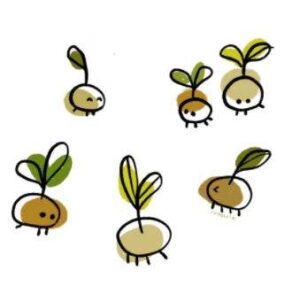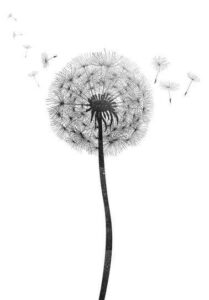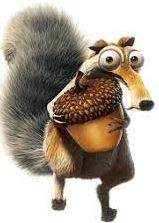Seeds
From Seed to Plant
The seed of a plant is not the same as the seed of an animal organism. The seed of a plant is already fertilised, it is a large spreading unit with a baby plant in it.
A plant makes seeds to propagate itself. From these seeds, new plants can grow. This is how the species can continue to exist.

Most plants make flowers and when these flowers are fertilized, fruits grow from them. Fruits contain pips or seeds.
If they end up in the right place, these seeds can become a new plant.
Seeds
Flowers of different plant species all look different. This also applies to their seeds. Sunflower seeds, for example, look very different from broad beans. And maize grains also look very different from rice grains. Yet, they are all seeds.
So there are as many kinds of seeds as there are flowers. Seeds always have a seedling, a port, a navel, 1 or 2 cotyledons, and a seed coat.
Seedling
In seeds, there is already a tiny plant. We call it the seedling. If a seed ends up in the right place, the seedling can start to grow.
The seed is in a good place if:
- There is enough water.
- It is warm enough.
- There is enough food in the soil.
- There is enough light to reach it.
- There is enough air for oxygen.
Porte and Navel
The seedling needs water, and this enters the seedling through the port. The port is a tiny hole near the navel. You can compare the navel of a seed with your navel.
Before the seed fell to the ground, it was in fruit. And that fruit gave the seed nutrition and water through an umbilical cord. As long as a human baby is in her womb, the mother also gives it food and water through an umbilical cord.
Therefore, the umbilicus is a small scar in seeds and in people where the umbilical cord used to be.
Cotyledons
The seedling does not need food right away. In a seed, there are 1 or 2 cotyledons. These cotyledons contain nutrients that the seedling needs to grow. That is why we sometimes call them food lobes.
The seedling first grows a root, taking water from the soil. Then it develops a stalk. This grows above the ground as quickly as possible to provide oxygen and sunlight.
If the young plant can collect enough food, water, and oxygen with its root and stem, it will no longer need the cotyledons. They will then quickly shrivel up and fall off.
Seed Coat
Each seed has a seed coat to keep the whole package of seedlings and cotyledons together. This is the outer skin of the seed. The seed coat looks very different on every seed.
We can often recognize seeds by their seed coat.

Just think of the difference between a wild and sweet chestnut. On the outside of the chestnut, you can see which one it is and, therefore, whether you can eat it or not. That’s handy, of course.
Growing
The young plant that grows from the seedling gets a longer and longer stem and more and more leaves. When the plant is mature, and it is time to flower, it forms buds. From these, flowers emerge that can be fertilized. And if these flowers produce fruits, these will again contain seeds for the next group of young plants.
Seed Plants
All trees are seed plants, just like all plants that make flowers. Seed plants consist of four organs:
- Roots
- Stems
- Leaves
- Flowers
Petals, pistils, and stamens are needed for reproduction. The stamens contain pollen with sperm cells. The pistils consist of a stigma and an ovary.
The stigma is the landing place for the pollen, and the ovary contains one or more ovules. The ovary becomes a fruit, for example, a melon. The ovum contains the egg cell.
After fertilization, the ovum becomes a seed with a baby plant inside. The sperm cells reach the egg cells through pollination, such as wind or insects. After landing on the stigma, a tube containing the sperm cells grows to the ovum and fertilizes the egg cell. There can be many seeds in one fruit.
Wind Pollinators Cause Hayfever
Every spring, people with hay fever experience that not all plants have insects on their carts to move their pollen. Well-known hay fever triggers are grasses, pines, and birches.
They use the wind to move the pollen. Wind pollination is these hayfever plants produce less efficiency than insect pollination, so many pollen.
That is a real bummer if you suffer from hay fever.
Seed Dispersal
After fertilization, an embryo grows in the young seed. The flower changes shape, and fruit with one or more seeds develops in which the source grows. The plant makes a safe jacket around it with excess food, and then the seed is ready. The seeds can go out into the world to grow into a new plant.
Close to the parent plant, they get too little light and nutrients from the soil, so plants and trees also have tricks to spread their seeds.
Some plants use the wind to do this, others use water, and still, others let animals make sure that they get a new home far away from the parent plant to a new home.
Some plants have seedpods with an explosion mechanism so that the seeds shoot away.
Wind Dispersal
A well-known wind disperser is a dandelion. A dandelion produces tiny, light umbrellas easily blown away by the wind. Each umbrella carries a seed at the bottom that contains a baby dandelion plant.

At the top, there is an umbrella made of fragile threads so that the wind can help it to spread. These are the fluffy threads that you see everywhere in spring.
Other wind dispersers are the willow, the poplar, and the cotton plant.
Seed Spreading by Water
Some seeds are dispersed by water. These seeds float well and can sometimes travel considerable distances. For example, when a coconut falls into the sea, it sometimes floats hundreds or thousands of kilometers. On another island, a new coconut tree can grow from the embryo in the coconut. The coconut is large and heavy, but it floats because there is air inside.
Other seeds that spread easily through the water are seeds of the yellow lily, the wood anemone, and many plants that grow on the side of ditches. That is why they are on the water’s edge.
Rivers can disperse seeds much further than the wind can. Therefore, plants make massive use of river basins. Seeds lying on the beach can sometimes come from the Caribbean: a journey of thousands of kilometers.
In the case of rivers, it is a journey of hundreds of kilometers, and it appears that plants make use of this on a large scale.
Seed Spreading by Animals
Everyone knows cleavers because it sticks to your clothes. It is a plant that spreads by sticking to animals and also people. The fruit has small curved hairs to stick to the fur of animals or clothes. Sometime later, they fall off, and a new plant can grow on that spot.
Sometimes seeds also spread in other ways. Cherries, for instance, are eaten by birds. The flesh decomposes, but the stone is defecated some distance away. There the stone can grow into a new cherry tree.
And there is another way in which animals help with the dispersal of seeds. For example, birds and rodents, such as mice and squirrels, collect acorns and beechnuts as a supply for the winter.

They often do not know precisely where their collections are or collect too much. In spring, new trees grow from these seeds.
Other seeds that animals spread are pine seeds by nutcrackers, violet seeds by ants, and walnuts by magpies.
Seed Spreading Under One’s Own Steam
A minimal number of plants and trees disperse their seeds by themselves. A well-known example is the seeds of the spring balsam or small spring grass.
You can see exploding seed pods from summer to autumn.
The plant is often found at forest edges.